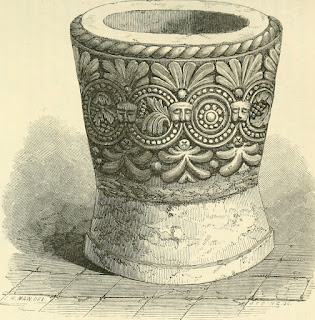A une quinzaine de kilomètres de Shrewsbury on peut faire une petite halte à l'église d'Uppington dédiée à la Sainte Trinité "Holly Trinity". L'église pourrait avoir des origines du XIe mais a été considérablement remaniée et ne garde de son passé roman qu'une petite porte dans le mur nord.
La porte est ornée d'un curieux et original tympan qui seul est en place et on ignore s'il existait auparavant des colonnes ou des chapiteaux . Le tympan est gravé en méplat dans une simple dalle en pierre de molasse passablement altérée par les effets des intempéries mais le dessin reste bien visible.
Le tympan est un assemblage de quatre sections avec dans sa partie basse un curieux morceau en demi-cercle qui semble ajout, ce qui n'est pas si évident car elle est de même consistance que le reste de l'œuvre. Peut-être ce serait une restauration ou pourquoi pas un réemploi très ancien.
Plus singulier encore, le choix du thème. Un immense dragon serpentiforme love sa longue queue dans tout le cadre de la sculpture formant des boucles et des vrilles .
Il semble porter des ailes et ouvre une large gueule faisant ressortir des dents acérées .
Ce genre de représentation est assez rare dans l'art des XIe et XIIe siècles, je n'ai pas trouvé de sources permettant une interprétation bien définie, mais on peut y trouver une influence nordique qui n'est pas étrangère à l'art de Grande-Bretagne .
Google translate.
The dragon of Uppington
About fifteen kilometers from Shrewsbury you can stop at Uppington Church dedicated to the Holy Trinity "Holly Trinity". The church could have origins in the 11th century but has been considerably altered and only retains from its Romanesque past a small door in the north wall.The door is decorated with a curious and original tympanum which alone is in place and it is not known whether there were columns or capitals before. The tympanum is carved flat in a simple molasse stone slab somewhat altered by the effects of bad weather, but the design remains clearly visible.The tympanum is an assembly of four sections with in its lower part a curious semi-circular piece which seems to add, which is not so obvious because it has the same consistency as the rest of the work. Maybe it would be a restoration or why not a very old reuse.More singular still, the choice of the topic. A huge serpent-shaped dragon coils its long tail throughout the frame of the sculpture forming curls and tendrils.It seems to wear wings and opens a wide mouth showing sharp teeth.This kind of representation is quite rare in the art of the 11th and 12th centuries, I have not found any sources allowing an interpretation, but one can find a Nordic influence there which is not foreign to the art of Britain .



















































